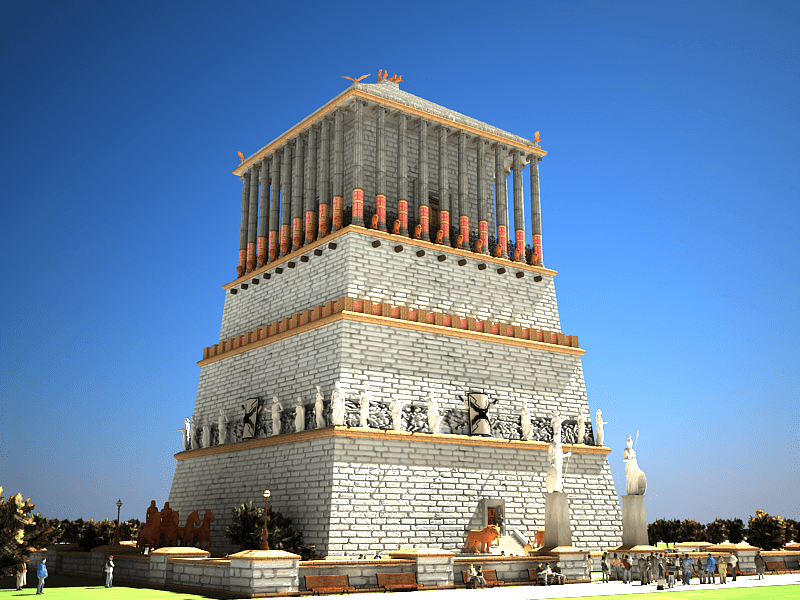Get ready to be amazed by the incredible Mausoleum at Halicarnassus! This ornate tomb, constructed in the 4th century BC, is brimming with captivating history. Join us as we delve into its architectural secrets, its construction, and its significance in the ancient world. The Mausoleum at Halicarnassus acts as a time capsule, offering a glimpse into the impressive skills and grandeur of a bygone era.
Mausoleum at Halicarnassus Facts: A Wonder Brought Down to Earth
Let’s be honest – most of us don’t spend our days contemplating ancient tombs. However, the Mausoleum at Halicarnassus was far from a typical gravesite. It was a testament to love, ambition, and artistic brilliance, forever etching its place in history as one of the Seven Wonders of the Ancient World.
Key Points of the Mausoleum at Halicarnassus:
- Erected by Artemisia II: Around 350 BC, Artemisia II commissioned this grand tomb to honor her husband, Mausolus, a powerful ruler in Caria (present-day Turkey).
- Designed by Greek Masters: Renowned architects Pythius and Satyros, celebrated for their innovative designs, were entrusted with the Mausoleum’s creation.
- Architectural Fusion: The Mausoleum seamlessly blended Greek, Near Eastern, and Egyptian architectural styles, showcasing a harmonious blend of design influences.
- A Visual Masterpiece: The structure featured a rectangular base adorned with elegant Ionic columns, a stepped pyramid rising from its center, and a stunning four-horse chariot sculpture at its pinnacle.
- Intricate Artwork: Every surface was lavishly decorated with intricate carvings depicting fierce battle scenes, captivating tales of gods and goddesses, and majestic portrayals of the royal family.
- Tourist Hotspot of Antiquity: The Mausoleum’s fame spread throughout the ancient world, drawing visitors eager to witness its grandeur firsthand.
- Victim of Time and Nature: Sadly, a series of earthquakes over centuries, particularly in the 11th, 12th, and 13th centuries, significantly weakened the structure.
- Further Degradation by Plunderers: To compound the damage, opportunistic plunderers seized valuable marble panels and sculptures from the weakened Mausoleum, further contributing to its demise.
- A Legacy in Ruins: By the 15th century, the once-mighty wonder lay in ruins, its fragments scattered. Today, only its foundation and a few scattered remnants remain at its original site in Bodrum, Turkey.
- Archaeological Enigma: Archaeologists continue to piece together the Mausoleum’s puzzle, searching for clues to its exact height, interior layout, and the whereabouts of its famed chariot horses.
- Enduring Inspiration: Though physically lost, the Mausoleum’s legacy lives on through its enduring influence on art and architecture, inspiring the word “mausoleum” and influencing grand tomb designs for centuries to come.
What is one fact about the Mausoleum at Halicarnassus that speaks to its enduring legacy?
The Mausoleum at Halicarnassus wasn’t just aesthetically impressive; it was incredibly durable! It stood strong for over 1,700 years, weathering attacks and even earthquakes! To put this in perspective, this structure endured longer than many empires. This incredible feat of engineering is a testament to the skill of its ancient builders, showcasing their dedication to creating a lasting monument. And they succeeded; the Mausoleum continues to captivate our imagination millennia later.
Why was the Mausoleum at Halicarnassus destroyed?
The Mausoleum at Halicarnassus, once a beacon of ancient architectural prowess, ultimately met its demise due to a combination of natural disasters and human actions.
The region where the Mausoleum stood was prone to seismic activity. Over the centuries, powerful earthquakes, notably those striking in the 11th, 12th, and 13th centuries, shook the region, weakening the Mausoleum’s once formidable structure.
As if these seismic blows weren’t enough, the Mausoleum also attracted opportunistic plunderers. Instead of appreciating its historical and artistic value, they saw it as a source of ready-made building materials. Over time, they stripped away its beautiful marble panels and intricate sculptures, likely repurposing them in their own constructions.
The cumulative effect of these earthquakes, weakening its structure, and the plundering of its supporting elements, ultimately led to the Mausoleum’s collapse.
It’s a poignant reminder that even the grandest creations are not impervious to the passage of time and the destructive tendencies of humankind. Today, we are left to piece together its story through the fragments and foundations that remain, a testament to the Mausoleum’s former glory.
What was the main purpose for building the Mausoleum at Halicarnassus?
The Mausoleum at Halicarnassus wasn’t merely intended as a tomb; it was a grand declaration of love, a testament to power, and a masterpiece of ancient art and architecture.
When Mausolus, ruler of Caria, died in 353 BC, his wife Artemisia II was devastated. Determined to create a monument worthy of her late husband, she envisioned the Mausoleum. This awe-inspiring edifice would become one of the Seven Wonders of the Ancient World.
The design was a magnificent fusion of Greek, Near Eastern, and Egyptian architectural styles, boasting intricate carvings, majestic statues, and a grand stepped pyramid roof. This wasn’t just about outward appearances; the interior, housing Mausolus’ tomb, was equally lavish.
Some scholars suggest that Artemisia II may have also intended the Mausoleum as a symbol of Caria’s prosperity and influence under Mausolus’s rule, adding another layer of meaning to this complex structure.
While earthquakes tragically destroyed the Mausoleum centuries ago, its legend persists, reminding us of the enduring power of love, the sting of loss, and humanity’s ability to create breathtaking works of art.
Is the Mausoleum of Halicarnassus Still Standing?
Sadly, the Mausoleum at Halicarnassus, once a breathtaking symbol of ancient architectural genius, no longer graces the skyline of modern-day Turkey. Time, an unforgiving sculptor, has reshaped this wonder into remnants and echoes of its former glory.
Over the centuries, earthquakes ravaged the region, weakening the Mausoleum’s foundations and causing significant structural damage. To make matters worse, as the structure lay vulnerable, people, perhaps driven by necessity or opportunism, took stones and marble for new constructions, further dismantling the once-great monument.
But don’t think for a moment that the Mausoleum’s story ends there! While its physical presence may have faded, its legacy is far from forgotten. Scattered pieces of its sculptures and architectural elements, carefully preserved in museums like the British Museum, offer tangible links to its glorious past. These fragments, like pieces of a puzzle, help us reconstruct its magnificence in our minds.
Furthermore, the Mausoleum’s influence extends far beyond its physical remains. Its innovative design and opulent decoration sparked a wave of inspiration that rippled through architectural history. Centuries later, artists and architects incorporated elements of its style into their creations, ensuring that the spirit of the Mausoleum lived on.
Although we may never experience the awe of standing in the shadow of the complete Mausoleum at Halicarnassus, we can still connect with its ingenuity. Through studying its fragments, historical accounts, and tracing its influence through time, we piece together a picture of this lost wonder.
Ongoing archaeological research continues to unearth new secrets, adding chapters to its captivating story and reminding us that even in ruin, the Mausoleum has much to teach us about art, history, and the enduring power of human achievement.
What was the purpose of the Mausoleum?
The Mausoleum at Halicarnassus transcended the function of a typical tomb. It was a testament to love, a symbol of power, and a showcase of artistic brilliance, all embodied in one magnificent structure.
When Mausolus, a powerful ruler in ancient Caria (part of the Persian Empire), passed away in 353 BC, his wife Artemisia II, who was also his sister (a common practice among rulers in that time and place), was heartbroken. Determined to create a monument that would forever honor his memory, she conceived of the Mausoleum.
This wasn’t meant to be just a simple burial chamber; it was a statement to the world, a physical manifestation of their power, their love, and the cultural sophistication of Caria.
The Mausoleum’s design was a breathtaking fusion of Greek, Near Eastern, and Egyptian architectural styles. Imagine a colossal structure, approximately 135 feet tall and 100 feet wide, with a massive rectangular base adorned with intricate carvings and majestic statues. Surrounding this base, 36 elegant Ionic columns supported a stepped pyramid roof, a symbol of eternity.
The Mausoleum’s exterior surfaces were masterpieces in themselves, covered in breathtaking artwork. Scenes from Greek myths, stories from Mausolus’s life, and intricate decorative motifs were all meticulously carved into the stone, showcasing the skill of the artisans.
The Mausoleum quickly became a source of pride for Caria and achieved recognition as one of the Seven Wonders of the Ancient World. Although earthquakes eventually reduced it to ruins, its legacy continues to inspire. The very word “mausoleum” comes from Mausolus’s tomb, illustrating how profoundly this structure impacted architectural design and language.
Although the Mausoleum no longer stands, its ruins in Bodrum, Turkey, continue to draw visitors from all over the world. They come to marvel at the scale of the monument, to imagine its former glory, and perhaps to reflect on the enduring power of love and loss that inspired its creation.
Who was the Mausoleum built for?
The Mausoleum at Halicarnassus, a wonder of the ancient world, was built for Mausolus, a powerful ruler in ancient Caria (a region in what is now Turkey). Mausolus wasn’t a king in the traditional sense, but as a satrap, he governed Caria under the authority of the Persian Empire.
When Mausolus passed away in 353 BC, his wife and sister, Artemisia II, was overcome with grief. Determined to create a monument that would forever commemorate her husband and showcase their power and wealth, she conceived of the Mausoleum.
Completed around 350 BC, the Mausoleum at Halicarnassus quickly became one of the most iconic structures in the ancient world. Imagine a towering edifice, approximately 135 feet tall, dominating the landscape. It featured a massive rectangular base adorned with intricate carvings and life-size sculptures, all supporting a stepped pyramid roof. Encircling this magnificent structure were 36 majestic Ionic columns, emphasizing its grandeur.
The Mausoleum’s exterior wasn’t just grand; it served as a canvas for breathtaking artwork. Scenes from Greek myths and pivotal moments from Mausolus’s life were etched in stone, showcasing the skill of the artists and the cultural influences of the time.
Sadly, like many architectural marvels of the ancient world, the Mausoleum couldn’t withstand the test of time. Earthquakes, occurring over several centuries, eventually caused its collapse. However, remnants of its former glory were rediscovered and excavated during the 19th century. These incredible artifacts, including sculptures and architectural fragments, offer a glimpse into its original splendor and are now primarily housed in the British Museum in London.
The Mausoleum’s impact extends far beyond its physical remains. The word “mausoleum” itself is derived from Mausolus’s tomb, a testament to its enduring legacy. This monumental tomb set a precedent for centuries to come, inspiring grand burial structures and leaving an indelible mark on architectural design and our understanding of ancient history.
Explore the Wonders of the Ancient World:
- Interesting Facts About the Hanging Gardens of Babylon
- Our Lady of Guadalupe Scientific Facts
- Horrible Facts About the Tudors
- Great Pyramid of Giza Math Facts
- Mastering Leader in Spanish: The Complete Guide - April 19, 2025
- Uncovering Surprising Parallels: England Size Compared to US States - April 19, 2025
- Old Mexico Map: Border Shifts 1821-1857 - April 19, 2025
















